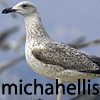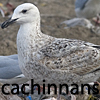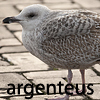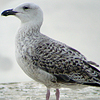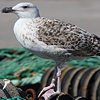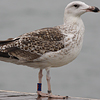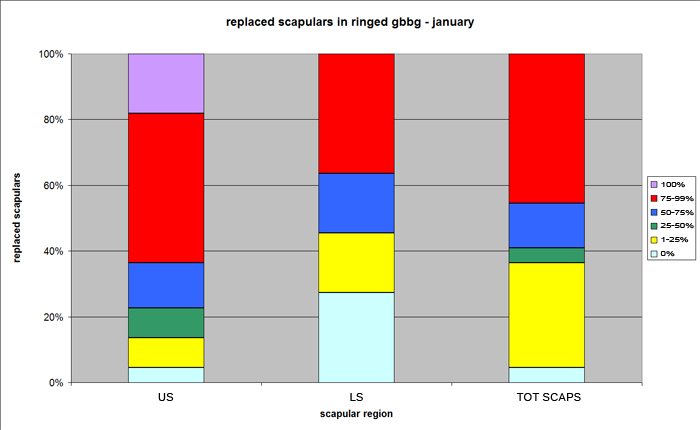 Great Black-backed Gull (Larus marinus)
Great Black-backed Gull (Larus marinus)
(last update: July 12, 2015)
Great Black-backed Gull 2cy January
Plumage sequences in 1cy and 2cy GBBG
The vast majority of Great Black-backed Gull follow a simple, classic moult sequence and moult timing, when compared to other large white-headed gull taxa in Europe. In this respect, it very much resembles Herring Gull. Both Herring and Great Black-backed Gull are nice species to monitor moult, as birds in these taxa replace (most of) the wing-coverts and tertials only once a year.
Only a very small fraction of 1cy Herring and Great Black-backed Gulls (about 2%) replace single coverts in the first autumn, but these exception birds can best be skipped to get a good picture of the normal moult sequences.
plumage 1cy August - 2cy April
The juvenile plumage in GBBG is largely attained until 2cy May; of course scapulars are replaced, but no replacement of coverts and tertials in the post-juvenile moult (autumn 1cy GBBG). This is different from taxa like graellsii, cachinnans and michahellis, where many individuals include the upper tertials and inner wing-coverts in a post-juvenile moult (see 5 example birds below).
The extent of post-juvenile moult in 5 taxa. Images are links: Larus fuscus graellsii (ringed in NW France) 2cy spring, February 12 2007, Agadir, Morocco. Larus michahellis 2cy spring, February 19 2012, Zagreb, Croatia. Larus cachinnans 2cy spring, February 19 2012, Zagreb, Croatia. Larus marinus (ringed in N Russia) 2cy spring February 08 2011, Scheveningen, the Netherlands. Larus argentatus argenteus (ringed in the Netherlands) 2cy spring, February 20 2011, IJmuiden, the Netherlands. |
Throughout the first winter period, marinus and argentatus keep a juvenile wing-covert panel that start to show wear at the fringes in spring. In these taxa, the first new coverts appear in early summer of the 2nd calendar year; covert moult is from May to late August.
plumage 2cy May - 2cy September
In summer all Herring and Great Black-backed Gulls renew all the wing-coverts and tertials for the first time. Most (and, in some birds, all) of these 2nd gen coverts are kept for the next 12 months. This wing-covert moult completely overlaps in time with the complete moult in summer, which starts when P1 is dropped in late-April or early May.
Of course, not all wing-coverts and tertials are shed simultaneously. Moult is initiated at certain loci, and then progresses throughout the entire wing-covert panel.
To completely replace the whole wing-covert panel, it takes about 4 months.
The progress of complete moult in coverts and tertials, in 5 stadia. 1. Normally, the first wing-coverts to be dropped are
innermost greater coverts, innermost median coverts and innermost lower lesser coverts. Then the process speeds up and some birds may have the complete set of central median coverts missing (see link 1). |
The 5 images above illustrate the process of the complete moult in the wing-coverts in the summer months. By August the wing-covert panel and tertials completely exists of 2nd gen feathers. In many birds this does not last very long, as 2cy autumn birds moult a limited set of wing-coverts and again the upper tertials; these feathers then turn into 3rd generation.
plumage 2cy September - 2cy November
By September we often see an extra moult in wing-coverts, which we call a "partial autumn moult" at this website. A partial autumn moult is seen in many white-headed gull species (graellsii, intermedius, michahellis) but Great Black-backed and Herring Gull are best to show what happens. We use "partial" in the definition, as it really is a very limited, yet common process.
For marinus and for argentatus (especially argenteus, far less in nominate argentatus), about 2/3 of the birds have a partial autumn moult in September - November. A limited number of feathers are replaced again, now turning into 3rd generation.
Included are upper tertials, innermost greater coverts, quite some median coverts (sometimes all visible MC) and randomly single lower lesser coverts and lesser coverts. It may be not a surprise that these are exactly the coverts which were replaced early in the complete moult process.
When scoring birds on partial autumn moult, you can fix on specific groups; e.g. in the greater coverts, only the very innermost feathers may be included, at most 4 or 5 feathers. The central and outer greater coverts always remain 2nd generation; only moulted once (late June) and not replaced again before June 3cy.
The partial autumn moult in 2cy GBBG. 1. & 2. 48C 2cy & 3cy, September 02 2008 and March 12 2009, Boulogne sur Mer, NW France. As 2cy in September, moult in coverts and tertials was finished. So how comes we see this bird back in March with many dark median coverts and inner greater coverts? Because a partial autmn moult took place. (see link 1 & 2). |
The pattern on these new 3rd generation feathers is highly variable. Often they very much resemble 2nd gen feathers, and if so, the only way to tell these feathers are 3rd gen, is by the buffish or greyish base. In other birds, the new 3rd gen feathers may appear more adult-like.
Central and outer greater coverts, and most of the lesser coverts as well, are only replaced one time in the annual cycle, they are never include in the partial autumn moult. Probably a very similar partial autumn moult can be found in all white-headed gull taxa, not only in marinus and argenteus. The problem describing such processes accurately lies in the extent of the post-juvenile moult. Marinus and argenteus do not include tertials and coverts in the post-juvenile moult, so we can very much assume where the complete moult starts, and we can easily tell that inner greater coverts and inner median coverts are replaced twice in their 2nd calendar year. But michahellis, graellsii and other taxa have highly variable post-juvenile moult in the wing-coverts, and subsequently it is much more difficult to tell exactly what is going on in summer and autumn. (Is this bird in July replacing the old juvenile feathers, or is it also replacing old 2nd gen feathers from the post-juvenile moult? Hence, will new feathers be 2nd gen or 3rd gen feathers? You just don't know. Only long periods of observations on ringed birds will lead to satisfying conclusions.)
Moult timing in first winter birds: January
Birds in the North Sea bassin and along the coasts of the Channel probably reached their winter grounds. Such birds already appear as early as August. Gradually it becomes colder in N Scandinavia and late hatched juveniles arrive as well after the first cold nights in November and December. This may explain why we still see birds with complete juvenile scapular region in January.
Tables:
| Moult in 2cy January GBBG - ringed birds. | |||||
| CODE | US |
LS |
TOT SCAPS |
||
| jh752 black | norway | january | 0 |
0 |
0 |
| jy283 black | denmark | january | 3 |
0 |
1 |
| 32n black | france | january | 1 |
0 |
1 |
| jp328 black | norway | january | 2 |
1 |
1 |
| ju120 black | norway | january | 2 |
0 |
1 |
| rum es17994 | russia | january | 1 |
0 |
1 |
| 0f4 black | usa | january | 2 |
0 |
1 |
| 1u4 black | usa | january | 3 |
0 |
1 |
| nla 7105677 | holland | january | 4 |
1 |
2 |
| nos 3032928 | norway | january | 3 |
1 |
2 |
| 1vv blue | britain | january | 4 |
1 |
3 |
| jp287 black | norway | january | 4 |
3 |
3 |
| jt365 black | norway | january | 4 |
2 |
3 |
| jz38 black | norway | january | 4 |
2 |
3 |
| 8j4 black | usa | january | 4 |
3 |
3 |
| 1va blue | britain | january | 5 |
4 |
4 |
| dkc 3076640 | denmark | january | 4 |
3 |
4 |
| j658w black | denmark | january | 4 |
4 |
4 |
| jw530 black | denmark | january | 4 |
4 |
4 |
| jym30 black | denmark | january | 5 |
4 |
4 |
| jyy02 black | denmark | january | 5 |
3 |
4 |
| jz113 black | denmark | january | 4 |
3 |
4 |
| j5ru blue | norway | january | 5 |
4 |
4 |
| ja615 black | norway | january | 5 |
4 |
4 |
| jh584 black | norway | january | 5 |
4 |
4 |
| jm89 black | norway | january | 4 |
4 |
4 |
| jt311 black | norway | january | 5 |
4 |
4 |
| jt787 black | norway | january | 5 |
4 |
4 |
| ju312 black | norway | january | 5 |
4 |
4 |
| jz8m blue | norway | january | 4 |
4 |
4 |
| kt13 white | russia | january | 4 |
4 |
4 |
below: graph corresponding to data from table 1. n=31. Distribution of replaced scapulars in January 2cy GBBG, separated into Upper Scapulars, Lower scapulars and for Total scapular region. Classification in 6 classes, running from 0% (no 2nd gen scaps) to 100% (all scaps in a region have been replaced).
In the column "Total scapulars" one ringed bird scored "0% 2nd gen scaps". In January JH752 from N Norway was still completely juvenile. When unringed birds are scored as well, such completely juvenile birds are encountered more often, probably origin from locations with less intensive ringing schemes.
The group of birds which score 100% 2nd gen scapulars gradually grow; remember however that 1st cycle birds, especially in March-April, grown fresh upper scapulars again, most probably 3rd gen feathers (feather condition was not scored by us). Figures in the graph may be read reverse, the presence of juvenile feathers decrease over time.
below: Great Black-backed Gull JA804 illustrates differences in colour and pattern between old juvenile 1st generation scapulars and fresh buffish 2nd generation feathers. Bird ringed as pullus on June 12 2012 at Salvøy, Karmøy, Rogaland, Norway (59°17'54"N 005°12'27"E). Picture: Jean-Michel Sauvage, September 28 2012, Boulogne-sur-Mer, NW France.
below: Distribution of replaced scapulars for "Total scapular region" for months August in hatch year until commencement of first complete moult in April. Classification in 6 classes, running from 0% (no 2nd gen scaps) to 100% (all scaps, including long rear scaps, have been replaced). Only ringed birds, n=238.
| Origin of all 191 ringed bird, used in our sample. Several individual birds observed in more than one month. | |
| britain | 13 |
| denmark | 25 |
| france | 19 |
| germany | 3 |
| holland | 3 |
| norway | 115 |
| russia | 2 |
| sweden | 1 |
| usa | 10 |
 Great Black-backed Gull (Larus marinus) KT13 2CY, January 08 2015, Boulogne-sur-Mer, France. Picture Jean-Michel Sauvage. From Russia.
Great Black-backed Gull (Larus marinus) KT13 2CY, January 08 2015, Boulogne-sur-Mer, France. Picture Jean-Michel Sauvage. From Russia. Great Black-backed Gull (Larus marinus) ES17994 2CY, January 21 & February 01 2015, Boulogne-sur-Mer, France. Picture Jean-Michel Sauvage. From Russia.
Great Black-backed Gull (Larus marinus) ES17994 2CY, January 21 & February 01 2015, Boulogne-sur-Mer, France. Picture Jean-Michel Sauvage. From Russia. Great
Black-backed Gull (Larus marinus) 2cy JZ8M January 25 2005, Vlissingen, the Netherlands (51.33N - 03.25E). Picture Frits.
Great
Black-backed Gull (Larus marinus) 2cy JZ8M January 25 2005, Vlissingen, the Netherlands (51.33N - 03.25E). Picture Frits. Great Black-backed Gull (Larus marinus) J5RU 2cy, January 06 2007, IJmuiden, the Netherlands (52.28 N - 04.35 E). Picture Leon Edelaar.
Great Black-backed Gull (Larus marinus) J5RU 2cy, January 06 2007, IJmuiden, the Netherlands (52.28 N - 04.35 E). Picture Leon Edelaar. Great Black-backed Gull (Larus marinus) JM89 2cy, January 19 2007, IJmuiden, the Netherlands (52.28 N - 04.35 E). Picture Robert Heemskerk.
Great Black-backed Gull (Larus marinus) JM89 2cy, January 19 2007, IJmuiden, the Netherlands (52.28 N - 04.35 E). Picture Robert Heemskerk. Great Black-backed Gull (Larus marinus) JZ38 1cy-2cy: August 2012 & January 2013, Scheveningen, the Netherlands.
Great Black-backed Gull (Larus marinus) JZ38 1cy-2cy: August 2012 & January 2013, Scheveningen, the Netherlands..jpg) Great Black-backed Gull (Larus marinus) J658W 2CY, 3CY & 5CY, January 2012, January 2013 & February 2015, IJmuiden, the Netherlands.
Great Black-backed Gull (Larus marinus) J658W 2CY, 3CY & 5CY, January 2012, January 2013 & February 2015, IJmuiden, the Netherlands. Great
Black-backed Gull JA615 (Larus marinus) 2cy: January 25 2009, Scheveningen, the Netherlands. Picture: M v Kleinwee.
Great
Black-backed Gull JA615 (Larus marinus) 2cy: January 25 2009, Scheveningen, the Netherlands. Picture: M v Kleinwee. Great
Black-backed Gull JH584 (Larus marinus) 2cy: January 20 2012, Scheveningen, the Netherlands.
Great
Black-backed Gull JH584 (Larus marinus) 2cy: January 20 2012, Scheveningen, the Netherlands. Great
Black-backed Gull JH752 (Larus marinus) 2cy: January 09 2012, Scheveningen, the Netherlands.
Great
Black-backed Gull JH752 (Larus marinus) 2cy: January 09 2012, Scheveningen, the Netherlands.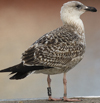 Great Black-backed Gull (Larus marinus) JP287 2cy: January & March 2012, IJmuiden, the Netherlands.
Great Black-backed Gull (Larus marinus) JP287 2cy: January & March 2012, IJmuiden, the Netherlands. Great Black-backed Gull (Larus marinus) JT311 1cy-2cy: November 2013 & January 2014, IJmuiden, the Netherlands.
Great Black-backed Gull (Larus marinus) JT311 1cy-2cy: November 2013 & January 2014, IJmuiden, the Netherlands..jpg) Great Black-backed Gull (Larus marinus) JP328 2cy, January 15 2012, IJmuiden, the Netherlands (52.28 N - 04.35 E).
Great Black-backed Gull (Larus marinus) JP328 2cy, January 15 2012, IJmuiden, the Netherlands (52.28 N - 04.35 E). Great Black-backed Gull (Larus marinus) JT365 2cy: January 11 2014, IJmuiden, the Netherlands. Picture: Jan Zorgdrager.
Great Black-backed Gull (Larus marinus) JT365 2cy: January 11 2014, IJmuiden, the Netherlands. Picture: Jan Zorgdrager. Great Black-backed Gull (Larus marinus) JT787 2cy: January 23 2015, Scheveningen, the Netherlands. Picture: Caroline Walta.
Great Black-backed Gull (Larus marinus) JT787 2cy: January 23 2015, Scheveningen, the Netherlands. Picture: Caroline Walta. Great Black-backed Gull (Larus marinus) JU120 2cy: January 26 2015, Hoek van Holland, the Netherlands. Picture: Ted van der Knaap.
Great Black-backed Gull (Larus marinus) JU120 2cy: January 26 2015, Hoek van Holland, the Netherlands. Picture: Ted van der Knaap. Great Black-backed Gull (Larus marinus) JU312 2CY, January 14 & February 23 2015, Scheveningen, the Netherlands.
Great Black-backed Gull (Larus marinus) JU312 2CY, January 14 & February 23 2015, Scheveningen, the Netherlands. Great
Black-backed Gull (Larus marinus) JW530 2cy: January & April 2012, Scheveningen & IJmuiden, the Netherlands.
Great
Black-backed Gull (Larus marinus) JW530 2cy: January & April 2012, Scheveningen & IJmuiden, the Netherlands. Great Black-backed Gull (Larus marinus) JY283 2cy, January 11 2013, Boulogne sur Mer, France. Picture Jean-Michel Sauvage.
Great Black-backed Gull (Larus marinus) JY283 2cy, January 11 2013, Boulogne sur Mer, France. Picture Jean-Michel Sauvage. Great Black-backed Gull (Larus marinus) JZ113 2CY, January 10 2015, Boulogne-sur-Mer, France. Picture Jean-Michel Sauvage.
Great Black-backed Gull (Larus marinus) JZ113 2CY, January 10 2015, Boulogne-sur-Mer, France. Picture Jean-Michel Sauvage.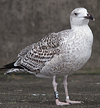 Great Black-backed Gull (Larus marinus) JYM30 2cy: January 03-05 2014, Scheveningen, the Netherlands. Picture: Vincent van der Spek & Ed Schouten.
Great Black-backed Gull (Larus marinus) JYM30 2cy: January 03-05 2014, Scheveningen, the Netherlands. Picture: Vincent van der Spek & Ed Schouten.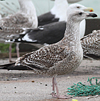 Great Black-backed Gull (Larus marinus) NOS 3032928 2CY, January 10 2015, Boulogne-sur-Mer, France. Picture Jean-Michel Sauvage.
Great Black-backed Gull (Larus marinus) NOS 3032928 2CY, January 10 2015, Boulogne-sur-Mer, France. Picture Jean-Michel Sauvage. Great Black-backed Gull (Larus marinus) DKC 3076640 2cy, January 08 2009, IJmuiden, the Netherlands.
Great Black-backed Gull (Larus marinus) DKC 3076640 2cy, January 08 2009, IJmuiden, the Netherlands. Great Black-backed Gull (Larus marinus) 32N 1cy-2cy, December 06 2013 & January 31 2014, Boulogne sur Mer, France. Picture Jean-Michel Sauvage.
Great Black-backed Gull (Larus marinus) 32N 1cy-2cy, December 06 2013 & January 31 2014, Boulogne sur Mer, France. Picture Jean-Michel Sauvage.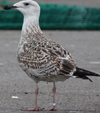 Great Black-backed Gull (Larus marinus) NLA 7105677 2cy, January 11 2013, Boulogne sur Mer, France. Picture Jean-Michel Sauvage.
Great Black-backed Gull (Larus marinus) NLA 7105677 2cy, January 11 2013, Boulogne sur Mer, France. Picture Jean-Michel Sauvage. Great Black-backed Gull (Larus marinus) 1VA 1CY-3CY, September 2013 - March 2015, Dublin, Ireland. Picture: Graham Prole.
Great Black-backed Gull (Larus marinus) 1VA 1CY-3CY, September 2013 - March 2015, Dublin, Ireland. Picture: Graham Prole. Great Black-backed Gull (Larus marinus) 1VV 1CY-3CY, November 2013 - July 2015, Dublin, Ireland. Picture: Graham Prole & Stephen Lawlor.
Great Black-backed Gull (Larus marinus) 1VV 1CY-3CY, November 2013 - July 2015, Dublin, Ireland. Picture: Graham Prole & Stephen Lawlor. Great Black-backed Gull (Larus marinus) 0F4 1st cycle (2CY), January 19 2010, New York. Picture: Appledore Blog.
Great Black-backed Gull (Larus marinus) 0F4 1st cycle (2CY), January 19 2010, New York. Picture: Appledore Blog. Great Black-backed Gull (Larus marinus) 1U4 1st cycle (2CY), January 12 2014, Galilee Harbor, RI. Picture: Keith Mueller.
Great Black-backed Gull (Larus marinus) 1U4 1st cycle (2CY), January 12 2014, Galilee Harbor, RI. Picture: Keith Mueller. Great Black-backed Gull (Larus marinus) 2T3 2cy, January 28 2012, Hatch Hill Landfill - Augusta, ME. Picture: Louis Bevier.
Great Black-backed Gull (Larus marinus) 2T3 2cy, January 28 2012, Hatch Hill Landfill - Augusta, ME. Picture: Louis Bevier. Great Black-backed Gull (Larus marinus) 8J4 1st cycle (1CY-2CY), December 2013 & January 2014, Galilee Harbor, RI. Picture: Keith Mueller.
Great Black-backed Gull (Larus marinus) 8J4 1st cycle (1CY-2CY), December 2013 & January 2014, Galilee Harbor, RI. Picture: Keith Mueller. Great Black-backed Gull (Larus marinus) BN 2CY, January 20 2017, Scheveningen, the Netherlands.
Great Black-backed Gull (Larus marinus) BN 2CY, January 20 2017, Scheveningen, the Netherlands. Great Black-backed Gull (Larus marinus) 2cy, January 13 2012, IJmuiden, the Netherlands.
Great Black-backed Gull (Larus marinus) 2cy, January 13 2012, IJmuiden, the Netherlands. Great Black-backed Gull (Larus marinus) 2cy, January 13 2012, IJmuiden, the Netherlands.
Great Black-backed Gull (Larus marinus) 2cy, January 13 2012, IJmuiden, the Netherlands. Great Black-backed Gull (Larus marinus) 2cy, January 13 2012, IJmuiden, the Netherlands.
Great Black-backed Gull (Larus marinus) 2cy, January 13 2012, IJmuiden, the Netherlands. Great Black-backed Gull (Larus marinus) 2cy, January 13 2012, IJmuiden, the Netherlands.
Great Black-backed Gull (Larus marinus) 2cy, January 13 2012, IJmuiden, the Netherlands. Great Black-backed Gull (Larus marinus) 2cy, January 13 2012, IJmuiden, the Netherlands.
Great Black-backed Gull (Larus marinus) 2cy, January 13 2012, IJmuiden, the Netherlands. Great Black-backed Gull (Larus marinus) 2cy, January 13 2012, IJmuiden, the Netherlands.
Great Black-backed Gull (Larus marinus) 2cy, January 13 2012, IJmuiden, the Netherlands. Great Black-backed Gull (Larus marinus) 2cy, January 13 2012, IJmuiden, the Netherlands.
Great Black-backed Gull (Larus marinus) 2cy, January 13 2012, IJmuiden, the Netherlands. Great Black-backed Gull (Larus marinus) 2cy, January 13 2012, IJmuiden, the Netherlands.
Great Black-backed Gull (Larus marinus) 2cy, January 13 2012, IJmuiden, the Netherlands. Great Black-backed Gull (Larus marinus) 2cy, January 13 2012, IJmuiden, the Netherlands.
Great Black-backed Gull (Larus marinus) 2cy, January 13 2012, IJmuiden, the Netherlands. Great Black-backed Gull (Larus marinus) 2cy, January 13 2012, IJmuiden, the Netherlands.
Great Black-backed Gull (Larus marinus) 2cy, January 13 2012, IJmuiden, the Netherlands. Great Black-backed Gull (Larus marinus) 2cy, January 13 2012, IJmuiden, the Netherlands.
Great Black-backed Gull (Larus marinus) 2cy, January 13 2012, IJmuiden, the Netherlands. Great Black-backed Gull (Larus marinus) 2cy, January 13 2012, IJmuiden, the Netherlands.
Great Black-backed Gull (Larus marinus) 2cy, January 13 2012, IJmuiden, the Netherlands. Great Black-backed Gull (Larus marinus) 2cy, January 13 2012, IJmuiden, the Netherlands.
Great Black-backed Gull (Larus marinus) 2cy, January 13 2012, IJmuiden, the Netherlands. Great Black-backed Gull (Larus marinus) 2cy, January 13 2012, IJmuiden, the Netherlands.
Great Black-backed Gull (Larus marinus) 2cy, January 13 2012, IJmuiden, the Netherlands. Great Black-backed Gull (Larus marinus) 2cy, January 13 2012, IJmuiden, the Netherlands.
Great Black-backed Gull (Larus marinus) 2cy, January 13 2012, IJmuiden, the Netherlands. Great Black-backed Gull (Larus marinus) 2cy, January 13 2012, IJmuiden, the Netherlands.
Great Black-backed Gull (Larus marinus) 2cy, January 13 2012, IJmuiden, the Netherlands. Great Black-backed Gull (Larus marinus) 2cy, January 13 2012, IJmuiden, the Netherlands.
Great Black-backed Gull (Larus marinus) 2cy, January 13 2012, IJmuiden, the Netherlands. Great Black-backed Gull (Larus marinus) 2cy, January 15 2012, IJmuiden, the Netherlands.
Great Black-backed Gull (Larus marinus) 2cy, January 15 2012, IJmuiden, the Netherlands. Great Black-backed Gull (Larus marinus) 2cy, January 15 2012, IJmuiden, the Netherlands.
Great Black-backed Gull (Larus marinus) 2cy, January 15 2012, IJmuiden, the Netherlands. Great Black-backed Gull (Larus marinus) 2cy, January 15 2012, IJmuiden, the Netherlands.
Great Black-backed Gull (Larus marinus) 2cy, January 15 2012, IJmuiden, the Netherlands. Great
Black-backed Gull (Larus marinus) 2cy: January 05 2007,
Scheveningen, the Netherlands.
Great
Black-backed Gull (Larus marinus) 2cy: January 05 2007,
Scheveningen, the Netherlands.
